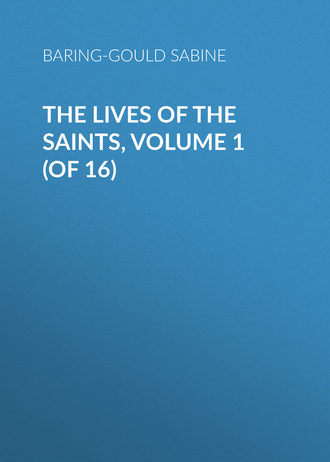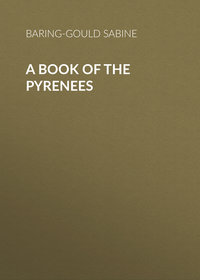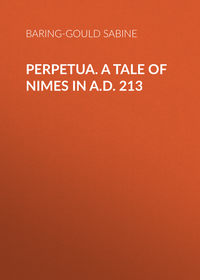 полная версия
полная версияThe Lives of the Saints, Volume 1 (of 16)
And when there was ever more and more of a concourse, and many desired to put themselves under his direction, he went forth, and sought out a suitable spot, and found it at Bayac, where he founded a monastery. There he remained some while, till a longing came over him to revisit Solignac, and he fled away when all his monks were asleep, as he had fled previously from Solignac. And when he reached Solignac, he was received with great joy. Then he asked the abbot Gundebert to build him a little cell outside the monastery, in which he might reside with one or two of the brethren who sought a stricter life. His wish was granted, and in this cell he spent the rest of his days.
He is regarded with special veneration at Iseghem, in Flanders, because he visited that place in company with S. Eligius, and there remained some time teaching the people.
In art, he is represented with a chalice in one hand and an abbatial staff in the other.
S. ALDRIC, B. OF MANS(a. d. 855.)[Gallican Martyrology. Ancient Life in Baluze: Miscel. iii.]
S. Aldric was born about the year 800. When aged fourteen his father sent him to the court of Louis the Pious. One day, as he was praying in church at Aix-la-Chapelle, he felt called by God to leave a life in the world, and dedicate himself to the service of the altar. With difficulty he persuaded the King to let him depart, and he was sent to the Bishop of Metz. There he remained some years, received the tonsure, and was ordained priest.
Louis the Pious, hearing of the wisdom and sanctity of Aldric, appointed him to be his chaplain and confessor. Aldric was afterwards elected Bishop of Mans, and was consecrated on the 22nd December, 832. When raised to the episcopal throne, he kept a stricter guard over himself, and treated his body with great rigour, but to others he was gentle and lenient. All his income was spent in works of mercy. He redeemed captives, relieved the poor, built churches, and founded monasteries. In the civil wars which divided the French monarchy, his fidelity to his prince and to Charles the Bald, his successor, involved him in trouble, and he was expelled for about a twelvemonth from his see. On his return, he laboured more indefatigably than ever to perfect the discipline of his diocese, for which purpose he collected the canons of Councils and decrees of the Popes into what he called a Capitulary. Some fragments have reached us of the regulations which he made for the celebration of divine service; in which he orders ten wax candles, and ninety lamps, to be lighted in his Cathedral on all great festivals.
S. CANUTE LAVARD, M(a. d. 1133.)[Schleswig and Scandinavian Breviaries. Life in Knytlinga Saga, Saxo Grammaticus, Schleswig Breviary, &c.]
Canute Lavard was second son of Eric the Good, King of Denmark. His elder brother, Nicolas, became King of Denmark, though he was illegitimate, as Canute was very young. Nicolas had a son named Magnus, who was also brought up with Canute. Canute purchased the duchy of Schleswig, and occupied himself with clearing the seas and islands of Denmark of the pirates who infested them. On one occasion, a pirate whom he had captured, and condemned with others to be hung, cried out that he was of royal blood, and was related to Canute. "Then," said the duke, "you shall hang at the topmast head above the others."
Henry, King of the Sclaves, being dead, Canute succeeded him. The popularity of this prince, owing to his gentleness, virtue, and piety, stirred up the envy of Magnus, who feared lest he should put in a claim to the throne of Denmark, to which indeed he had a right prior to Magnus and his father. In order to make sure of the succession, Magnus decoyed his unsuspicious kinsman into a wood, surrounded him with armed men, and killed him.
January 8
S. Lucian, B. M., and Companions, at Beauvais. S. Patiens, B. of Metz, circ. a.d. 152. S. Atticus, Patr. of Constantinople, a.d. 425. S. Severinus, P. and Apostle of Austria, a.d. 482. S. Severinus, B. C., in Italy, 6th cent. B. Baldwin, Archdeacon of Laon, M., 6th cent. S. Frodobert, Ab., at Troyes, 7th cent. S. Gudula, V., at Brussels, circ. a.d. 712. S. Pega, V., in England, circ. a.d. 718. S. Erard, Bishop in Bavaria, 8th cent. S. Garibald, B. of Ratisbon, circ. a.d. 1252. S. Wulsin, B. of Sherbourn, a.d. 983. S. Laurence Justiniani, Patr. of Venice, a.d. 1455.
S. LUCIAN, B. M. AT BEAUVAIS[Roman, Gallican, and Anglican Martyrologies; Bede, Ado, Notker, and others. His date uncertain. As little is known of this S. Lucian, it is probable that the so-called Reformers retained his name in the Anglican Calendar by mistake, confusing him with the S. Lucian of Antioch, Jan. 7th, a much better known Saint.]
There is much uncertainty about this martyr. Some writers maintain that he was a disciple of S. Peter. Others say that he was sent into Gaul by S. Clement, Bishop of Rome, at the end of the first century, and suffered death under the reign of Domitian. It is certain, however, that he came into Gaul to preach the faith to the pagan inhabitants, and that he finished his labours at Beauvais, by the death of a martyr. There is good reason to believe that he was of noble Roman blood, and that he accompanied S. Denys of Paris, or S. Quentin of Amiens, on his mission, about the year 245. S. Lucian was accompanied by his friends, Maximian and Julian. They suffered in different places, and on different days; but they were laid by faithful disciples in one tomb, and are commemorated together. S. Lucian is called in some calendars a priest; but in an ancient one of the ninth century, he is styled a bishop, and such has been the constant tradition at Beauvais.
In art, he is represented holding his head in his hands.
S. PATIENS, B(about a.d. 152.)[Roman Martyrology; Martyrologies of Cologne, of Rabanus, Notker, &c. His life is traditional.]
S. Patiens is said to have been a disciple of S. John the Evangelist, and to have been sent by him into Gaul. He settled at Metz, where he became the fourth Bishop.
S. ATTICUS, PATR. OF CONSTANTINOPLE(a. d. 425.)[Roman Martyrology, that of Usuardus and the German Martyrologies. Authorities for his life, very numerous: Socrates, Sozomen, Synesius, Palladius, Photius, Nicephorus, Zonaras, &c.]
Atticus, a man of gentle spirit and conciliatory manners, succeeded S. Chrysostom in the see of Constantinople. He, at first, refused to admit the name of his predecessor into the diptychs; but was afterwards moved to yield, in accordance with the Latin Church, which refused communion with the see of Constantinople till the righteousness of the cause of the great Chrysostom had been acknowledged. Atticus was engaged in correspondence on this subject with S. Cyril of Alexandria, who vehemently resented the admission of the name of Chrysostom, till he also yielded at the instance of Isidore of Pelusium.
S. SEVERINUS, P. AP. OF NORICUM(a. d. 482.)[Roman Martyrology and those of Germany. The life of S. Severinus was written by his disciple, Eugippius, in the year 511, as he states in a letter to Paschatius, the deacon. The following life is extracted from Mr. Kingsley's "Hermits,"34 with certain necessary modifications. What has been once well done, the author is unwilling to do again, and do in an inferior manner.]
In the middle of the fifth century the province of Noricum (Austria, as we should now call it), was the very highway of invading barbarians, the centre of the human Maelstrom, in which Huns, Allemanni, Rugii, and a dozen wild tribes more, wrestled up and down, and round the starving and beleaguered towns of what had once been a happy and fertile province, each tribe striving to trample the other under foot, and to march southward, over their corpses, to plunder what was still left of the already plundered wealth of Italy and Rome. The difference of race, of tongue, and of manners, between the conquered and their conquerors, was made more painful by difference in creed. The conquering Germans and Huns were either Arians or heathens. The conquered race (though probably of very mixed blood), who called themselves Romans, because they spoke Latin, and lived under the Roman law, were orthodox Catholics; and the miseries of religious persecution were too often added to the usual miseries of invasion.
It was about the year 455-60. Attila, the great King of the Huns, who called himself – and who was – "the Scourge of God" was just dead. His empire had broken up. The whole centre of Europe was in a state of anarchy and war; and the hapless Romans along the Danube were in the last extremity of terror, not knowing by what fresh invader their crops would be swept off up to the very gates of the walled towers, which were their only defence; when there appeared among them, coming out of the East, a man of God.
Who he was he would not tell. His speech showed him to be an African Roman – a fellow-countryman of S. Augustine – probably from the neighbourhood of Carthage. He had certainly at one time gone to some desert in the East, zealous to learn "the more perfect life." Severinus, he said, was his name; a name which indicated high rank, as did the manners and the scholarship of him who bore it. But more than his name he would not tell. "If you take me for a runaway slave," he said, smiling, "get ready money to redeem me with when my master demands me back." For he believed that they would have need of him; that God had sent him into that land that he might be of use to its wretched people. And certainly he could have come into the neighbourhood of Vienna, at that moment, for no other purpose than to do good, unless he came to deal in slaves.
He settled first at a town, called by his biographer Casturis; and, lodging with the warden of the church, lived quietly the hermit life. Meanwhile the German tribes were prowling round the town; and Severinus, going one day into the church, began to warn the priests and clergy, and all the people, that a destruction was coming on them which they could only avert by prayer, and fasting, and the works of mercy. They laughed him to scorn, confiding in their lofty Roman walls, which the invaders – wild horsemen, who had no military engines – were unable either to scale or batter down. Severinus left the town at once, prophesying, it was said, the very day and hour of its fall. He went on to the next town, which was then closely garrisoned by a barbarian force, and repeated his warning there: but while the people were listening to him, there came an old man to the gate, and told them how Casturis had been already sacked, as the man of God had foretold; and going into the church, threw himself at the feet of S. Severinus, and said that he had been saved by his merits from being destroyed with his fellow-townsmen.
Then the dwellers in the town hearkened to the man of God, and gave themselves up to fasting, and almsgiving, and prayer for three whole days.
And on the third day, when the solemnity of the evening sacrifice was fulfilled, a sudden earthquake happened, and the barbarians, seized with panic fear, and probably hating and dreading – like all those wild tribes – confinement between four stone walls, instead of the free open life of the tent and the stockade, forced the Romans to open their gates to them, rushed out into the night, and, in their madness, slew each other.
In those days a famine fell upon the people of Vienna; and they, as their sole remedy, thought good to send for the man of God from the neighbouring town. He went, and preached to them, too, repentance and almsgiving. The rich, it seems, had hidden up their stores of corn, and left the poor to starve. At least S. Severinus discovered (by divine revelation, it was supposed), that a widow named Procula had done as much. He called her out into the midst of the people, and asked her why she, a noble woman and free-born, had made herself a slave to avarice, which is idolatry. If she would not give her corn to Christ's poor, let her throw it into the Danube to feed the fish, for any gain from it she would not have. Procula was abashed, and served out her hoards thereupon willingly to the poor; and a little while afterwards, to the astonishment of all, vessels came down the Danube laden with every kind of merchandize. They had been frozen up for many days near Passau, in the thick ice of the river Enns: but the prayers of God's servant had opened the ice-gates, and let them down the stream before the usual time.
Then the wild German horsemen swept around the walls, and carried off human beings and cattle, as many as they could find. Severinus, like some old Hebrew prophet, did not shrink from advising hard blows, where hard blows could avail. Mamertinus, the tribune, or officer in command, told him that he had so few soldiers, and those so ill-armed, that he dare not face the enemy. Severinus answered that they should get weapons from the barbarians themselves; the Lord would fight for them, and they should hold their peace: only if they took any captives they should bring them safe to him. At the second milestone from the city they came upon the plunderers, who fled at once, leaving their arms behind. Thus was the prophecy of the man of God fulfilled. The Romans brought the captives back to him unharmed. He loosed their bonds, gave them food and drink, and let them go. But they were to tell their comrades that, if ever they came near that spot again, celestial vengeance would fall on them, for the God of the Christians fought from heaven in his servants cause.
So the barbarians trembled, and went away. And the fear of S. Severinus fell on all the Goths, heretic Arians though they were; and on the Rugii, who held the north bank of the Danube in those evil days. S. Severinus, meanwhile, went out of Vienna, and built himself a cell at a place called "At the Vineyards." But some benevolent impulse – divine revelation his biographer calls it – prompted him to return, and build himself a cell on a hill close to Vienna, round which other cells soon grew up, tenanted by his disciples. "There," says his biographer, "he longed to escape the crowds of men who were wont to come to him, and cling closer to God in continual prayer: but the more he longed to dwell in solitude, the more often he was warned by revelations not to deny his presence to the afflicted people." He fasted continually; he went barefoot even in the midst of winter, which was so severe, the story continues, in those days around Vienna, that waggons crossed the Danube on the solid ice: and yet, instead of being puffed-up by his own virtues, he set an example of humility to all, and bade them with tears to pray for him, that the Saviour's gifts to him might not heap condemnation on his head.
Over the wild Rugii S. Severinus seems to have acquired unbounded influence. Their king, Flaccitheus, used to pour out his sorrows to him, and tell him how the princes of the Goths would surely slay him; for when he had asked leave of him to pass on into Italy, he would not let him go. But S. Severinus prophesied to him that the Goths would do him no harm. Only one warning he must take: "Let it not grieve him to ask peace even for the least of men."
The friendship which had thus begun between the barbarian king and the cultivated Saint was carried on by his son Feva: but his "deadly and noxious wife," Gisa, who appears to have been a fierce Arian, always, says his biographer, kept him back from clemency. One story of Gisa's misdeeds is so characteristic both of the manners of the time and of the style in which the original biography is written, that I shall take leave to insert it at length.
"The King Feletheus (who is also Feva), the son of the afore-mentioned Flaccitheus, following his father's devotion, began, at the commencement of his reign, often to visit the holy man. His deadly and noxious wife, named Gisa, always kept him back from the remedies of clemency. For she, among the other plague-spots of her iniquity, even tried to have certain Catholics re-baptized: but when her husband did not consent, on account of his reverence for S. Severinus, she gave up immediately her sacrilegious intention, burdening the Romans, nevertheless, with hard conditions, and commanding some of them to be exiled to the Danube. For when one day, she, having come to the village next to Vienna, had ordered some of them to be sent over the Danube, and condemned to the most menial offices of slavery, the man of God sent to her, and begged that they might be let go. But she, blazing up in a flame of fury, ordered the harshest of answers to be returned. 'I pray thee,' she said, 'servant of God, hiding there within thy cell, allow us to settle what we choose about our own slaves.' But the man of God hearing this, 'I trust,' he said, 'in my Lord Jesus Christ, that she will be forced by necessity to fulfil that which in her wicked will she has despised.' And forthwith a swift rebuke followed, and brought low the soul of the arrogant woman. For she had confined in close custody certain barbarian goldsmiths, that they might make regal ornaments. To them the son of the aforesaid king, Frederick by name, still a little boy, had gone in, in childish levity, on the very day on which the queen had despised the servant of God. The goldsmiths put a sword to the child's breast, saying, that if any one attempted to enter, without giving them an oath that they should be protected, he should die; and that they would slay the king's child first, and themselves afterwards, seeing that they had no hope of life left, being worn out with long prison. When she heard that, the cruel and impious queen, rending her garments for grief, cried out, 'O servant of God, Severinus, are the injuries which I did thee thus avenged? Hast thou obtained, by the earnest prayer thou hast poured out, this punishment for my contempt, that thou shouldst avenge it on my own flesh and blood?' Then, running up and down with manifold contrition and miserable lamentation, she confessed that for the act of contempt which she had committed against the servant of God she was struck by the vengeance of the present blow; and forthwith she sent knights to ask for forgiveness, and sent across the river the Romans, his prayers for whom she had despised. The goldsmiths, having received immediately a promise of safety, and giving up the child, were in like manner let go.
"The most reverend Severinus, when he heard this, gave boundless thanks to the Creator, who sometimes puts off the prayers of suppliants for this end, that as faith, hope, and charity grow, while lesser things are sought, He may concede greater things. Lastly, this did the mercy of the Omnipotent Saviour work, that while it brought to slavery a woman free, but cruel over much, she was forced to restore to liberty those who were enslaved. This having been marvellously gained, the queen hastened with her husband to the servant of God, and showed him her son, who, she confessed, had been freed from the verge of death by his prayers, and promised that she would never go against his commands."
To this period of Severinus' life belongs the famous story of his interview with Odoacer, the first barbarian king of Italy, and brother of the great Onulf or Wolf, who was the founder of the family of the Guelphs, Counts of Altorf, and the direct ancestors of Victoria, Queen of England. Their father was Ædecon, secretary at one time of Attila, and chief of the little tribe of Turklings, who, though German, had clung faithfully to Attila's sons, and came to ruin at the great battle of Netad, when the empire of the Huns broke up at once and for ever. Then Odoacer and his brother started over the Alps to seek their fortunes in Italy, and take service, after the fashion of young German adventurers, with the Romans; and they came to S. Severinus' cell, and went in, heathens as they probably were, to ask a blessing of the holy man; and Odoacer had to stoop and to stand stooping, so huge he was. The Saint saw that he was no common lad, and said, "Go to Italy, clothed though thou be in ragged sheepskins: thou shalt soon give greater gifts to thy friends." So Odoacer went up into Italy, deposed the last of the Cæsars, a paltry boy, Romulus Augustulus by name, and found himself, to his own astonishment, and that of all the world, the first German king of Italy; and, when he was at the height of his power, he remembered the prophecy of Severinus, and sent to him, offering him any boon he chose to ask. But all that the Saint asked was, that he should forgive some Romans whom he had banished. S. Severinus meanwhile foresaw that Odoacer's kingdom would not last, as he seems to have foreseen many things. For when certain German knights were boasting before him of the power and glory of Odoacer, he said that it would last some thirteen, or at most fourteen years; and the prophecy (so all men said in those days) came exactly true.
There is no need to follow the details of S. Severinus's labours through some five-and-twenty years of perpetual self-sacrifice – and, as far as this world was concerned, perpetual disaster. Eugippius's chapters are little save a catalogue of towns sacked one after the other, from Passau to Vienna, till the miserable survivors of the war seemed to have concentrated themselves under S. Severinus's guardianship in the latter city. We find, too, tales of famine, of locust-swarms, of little victories over the barbarians, which do not arrest wholesale defeat: but we find, through all, S. Severinus labouring like a true man of God, conciliating the invading chiefs, redeeming captives, procuring for the cities which were still standing supplies of clothes for the fugitives, persuading the husbandmen, seemingly through large districts, to give even in time of dearth a tithe of their produce to the poor; – a tale of noble work indeed.
Eugippius relates many wonders in his life of S. Severinus. The reader finds how the man who had secretly celebrated a heathen sacrifice was discovered by S. Severinus, because, while the tapers of the rest of the congregation were lighted miraculously from heaven, his taper alone would not light. He records how the Danube dared not rise above the mark of the cross which S. Severinus had cut upon the posts of a timber chapel; how a poor man, going out to drive the locusts off his little patch of corn instead of staying in the church all day to pray, found the next morning that his crop alone had been eaten, while all the fields around remained untouched. Also he records the well-known story, which has a certain awfulness about it, how S. Severinus watched all night by the bier of the dead priest Silvinus, and ere the morning dawned bade him, in the name of God, speak to his brethren; and how the dead man opened his eyes, and Severinus asked him whether he wished to return to life, and he answered complainingly, "Keep me no longer here; nor cheat me of that perpetual rest which I had already found," and so, closing his eyes once more, was still for ever.
At last the noble life wore itself out. For two years Severinus had foretold that his end was near; and foretold, too, that the people for whom he had spent himself should go forth in safety, as Israel out of Egypt, and find a refuge in some other Roman province, leaving behind them so utter a solitude, that the barbarians, in their search for the hidden treasures of the civilization which they had exterminated, should dig up the very graves of the dead. Only, when the Lord willed to deliver them, they must carry away his bones with them, as the children of Israel carried the bones of Joseph.
Then Severinus sent for Feva, the Rugian king and Gisa, his cruel wife; and when he had warned them how they must render an account to God for the people committed to their charge, he stretched his hand out to the bosom of the king. "Gisa," he asked, "dost thou love most the soul within that breast, or gold and silver?" She answered that she loved her husband above all. "Cease then," he said, "to oppress the innocent: lest their affliction be the ruin of your power."
Severinus' presage was strangely fulfilled. Feva had handed over the city of Vienna to his brother Frederick – "poor and impious," says Eugippius. Severinus, who knew him well, sent for him, and warned him that he himself was going to the Lord; and that if, after his death, Frederick dared touch aught of the substance of the poor and the captive, the wrath of God would fall on him. In vain the barbarian pretended indignant innocence; Severinus sent him away with fresh warnings.









